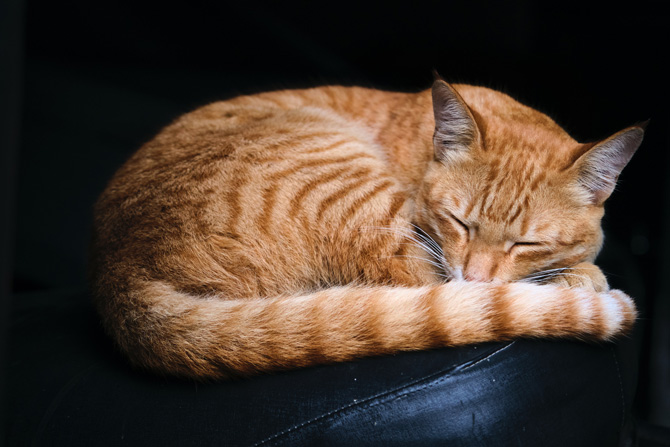Arthritis in cats is common. In fact, some studies show that up to 90% of our feline friends over 12 years of age have arthritis. However, despite arthritis being widespread in older cats, it is also under-diagnosed.
As pet professionals, you play a key role in recognising the signs of arthritis in cats and helping cat owners to seek appropriate advice and treatment. Indeed, it may be that you notice a cat in your care is showing symptoms of arthritis.
Symptoms of arthritis in cats
There are many signs that may indicate arthritis in cats. Common symptoms include:
Reduced mobility
- Reluctant to jump. May hesitate before jumping onto a high surface
- Not jumping as high as normal
- Shows signs of difficulty when walking up or down stairs
- Stiffness in legs or obvious lameness, particularly after long periods of rest/immobility
- Seems to have difficulty using the litter tray
- Isn’t as mobile when entering the house through the cat flap
Changes in activity
- Sleeps for longer periods
- Seems uninteresting in going outdoors or hunting
- Shows less interest in interaction with humans or other animals
- Sleeps in a different place (likely to be an easier-to-access spot)
Changes in grooming habits
- Spends less time grooming
- Grooms less often
- Coat has become matted
- Claws have become long as a result of immobility/lack of activity
Altered behaviour or temperament
- Seems withdrawn/spends more time alone
- Shows signs of irritability when interacted with
- Not interested in being petted or stroked
Causes & risk factors
Just like in humans, osteoarthritis refers to the wear and tear of the joints. It most commonly affects the elbows, hips and spine. Having said that, arthritis can affect any joint on the body and may affect more than one joint.
Arthritis can develop following a joint injury or trauma. However, other possible risk factors include obesity and genetics.
Breeds considered to be more prone to arthritis include Maine Coon, Persians, Siamese, Scottish Folds, Abyssinians and Himalayan. This is mostly due to other genetic health problems seen in these breeds, such as hip dysplasia, cartilage abnormalities and patella luxation.
Advice for clients
Certainly, it could be that a client suspects their cat has arthritis and turns to you for advice. A really useful resource is the ‘mobility checklist’ from International Cat Care.
You can encourage cat owners who are concerned about their feline friends to download the checklist to identify changes in their purring pals that could suggest arthritis is present.
If symptoms are identified, owners should be advised to consult their vet for a proper diagnosis. The vet may wish to perform an X-ray. Alternatively, a course of anti-inflammatory drugs may be trialed.
Pet professionals can highlight the importance of at-home changes to help improve a cat’s quality of life and comfort. In some cases, just a few minor adjustments can make all the difference.
Caring for a cat with arthritis
Aside from medication provided by the vet, there are some easy changes a pet owner or pet sitter can make to assist their arthritic cat. Simple steps that can reduce a cat’s pain and ease its discomfort include:
- Move its bed to an easier-to-access place
- Make sure the bed is soft and positioned in a peaceful, draft-free area of the home
- If there are higher areas the cat enjoys sitting, such as a favourite sofa or windowsill consider placing steps next to it to make it easier and less painful for the cat to access
- Use a litter tray with low sides and make sure there’s a litter tray indoors
- Ensure food and water as easy to access, at ground level
- Spend some time grooming the cat and keep its claws short with regular trims
Diet & medication
Obesity is not only a risk factor for arthritis but it can also exacerbate the condition. As such, overweight cats will need to be placed on a controlled diet.
A vet might also recommend a supplement or a prescription diet. These typically contain essential fatty acids and ingredients like glucosamine to help reduce inflammation.
With regards to medication for arthritis, there are non-steroidal anti-inflammatory drugs (NSAIDs) to address the pain and inflammation and also disease-modifying osteoarthritis drugs, which are administered as a series of injections.
Medication can be effective in improving a cat’s quality of life and reducing its discomfort. However, a vet should closely monitor any medications provided to the cat.
Certainly, the fact that arthritis in cats is widely under-diagnosed suggests there may be many older cats that are living in pain. Pet professionals play a vital role in watching out for the signs of arthritis in older cats in their care.
You can also discuss the topic of arthritis with your clients so they are also mindful of the symptoms to be aware of.
Information sources
Arthritis in cats. Perth Cat Hospital. Accessed online June 2021 via: http://www.perthcathospital.com.au/arthritis-in-cats/
Arthritis & degenerative joint disease in cats. International Cat Care. July 2018. Accessed online June 2021 via: https://icatcare.org/advice/arthritis-and-degenerative-joint-disease-in-cats/
Image source: Himanshu Choudhary on Unsplash
Latest posts by Liz Walden (see all)
- Pet health: Medicinal cannabis for pets - December 27, 2021
- What pet business insurance do I need? - November 17, 2021
- Pet sitters: how to take time off - November 15, 2021










Leave A Comment